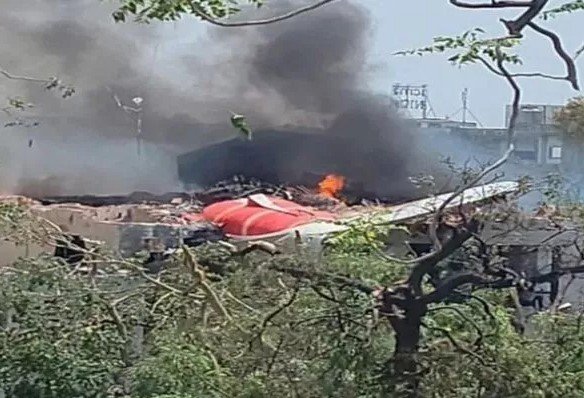Focus turns to sensor glitch, switch behavior, and hauntingly similar aborted takeoff just six months earlier
The questions now aren’t just about what went wrong after takeoff. Investigators are trying to figure out if something started going wrong even before the aircraft left the ground.
That’s where the electrical system—and one particular switch—is suddenly under a very bright spotlight.
A catastrophic crash, and a puzzle that begins with a sensor
On the morning of June 12, 2025, Air India flight AI-171 lifted off from Ahmedabad airport, bound for London Gatwick. Less than a minute later, the aircraft nosedived and exploded on impact, killing all 241 passengers and 19 crew members on board.
What has since followed is a painstaking effort to piece together what happened in those horrifying seconds. But what’s emerging now is something even more unsettling: a potential history of electrical faults and software misfires on the very same aircraft that crashed.
Hours before takeoff, the aircraft—after arriving from Delhi—had already recorded a technical anomaly: a Stabilizer Position Transducer Defect. That’s a mouthful, but in simple terms, it means the sensor responsible for controlling how the aircraft tilts up or down wasn’t talking properly to the flight computer.
The engineer signed off after troubleshooting the issue, reportedly following Boeing’s manual to the letter.
But something may have still been off.

The switch that may have switched itself
This is where things get chilling.
Officials close to the investigation say they’re now zeroing in on whether the fuel control switches, which manage the engine’s fuel flow, moved into cut-off mode on their own, without pilot input—what aviation experts call an “un-commanded transition.”
That kind of behavior is rare. Very rare. But not impossible.
If true, it would mean that the engines stopped getting fuel seconds after takeoff. In that case, the aircraft wouldn’t stand a chance.
Even more troubling? There’s precedence. Not in a vague, years-ago sense, but just six months earlier, and involving the exact same flight.
The December 12 incident nobody wants to overlook
Back on December 12, 2024, the same scheduled AI-171 flight from Ahmedabad to Gatwick didn’t even make it to the runway.
Air India aborted boarding after engineers discovered a “massive technical snag.” Officially, not much was said about what exactly went wrong that day. But now, with 260 lives lost, that previously brushed-aside event is getting a second look.
Some of the issues raised then—electrical system alerts and software flags—are eerily similar to the ones being looked at now.
Investigators retracing steps, one component at a time
So far, the probe has focused on a few key areas:
-
The stabilizer sensor and how its electrical signals are interpreted
-
Whether software glitches could have falsely reported flight dynamics
-
The logic built into the fuel control switch system and whether it’s prone to auto-shutdowns in certain conditions
Here’s a simplified look at the components being reviewed:
| Component | Role in Aircraft | Current Focus in Investigation |
|---|---|---|
| Stabilizer Position Transducer | Controls aircraft pitch | Reported faulty before crash |
| Fuel Control Switches | Manages engine fuel flow | Suspected of “un-commanded” shut-off |
| Flight Control System | Interprets pilot commands | Potential misinterpretation of sensor data |
| Electrical Wiring/Relays | Transmits power and signals | Possible malfunction or short-circuit |
One engineer involved in a related Air India maintenance program admitted off the record that electrical issues in older aircraft sometimes “get resolved on paper” but aren’t truly fixed. “If the fault doesn’t repeat during testing, it’s cleared,” he said. “But that doesn’t mean it’s gone.”
Pilots, engineers, and past flight logs under review
Now the Directorate General of Civil Aviation (DGCA) has reportedly pulled all maintenance and flight logs tied to the aircraft going back a full year.
Several senior pilots who flew the jet have been quietly questioned.
One of them apparently flagged minor switch lags and sensor readings being “off by a few degrees” in earlier logs. At the time, those quirks didn’t raise alarms.
“They weren’t treated like red flags,” said a senior official. “But maybe they should’ve been.”
In fact, that’s one of the painful lessons being unearthed—small issues, noted in logbooks, might hint at something deeper, something systemic.
Air India facing hard questions over fleet safety
The national carrier, which merged with Vistara and came under Tata Group’s umbrella, has generally worked to improve safety standards. But this case is peeling back layers that show all wasn’t smooth under the surface.
The December 12 issue especially stands out. According to multiple sources, boarding had already started when engineers pulled the plug.
That decision likely prevented another disaster. But what’s unclear is whether the fix implemented then held up in the long run.
• Engineers reportedly used a software patch update for electrical resets
• Component replacements were deferred due to “lack of spare units”
• Pilots reported improvement in pitch response but weren’t entirely confident
One pilot noted in the log: “Trim feels better. Still a delay in pitch settle.”
That delay may not mean much on a good day. But on a takeoff roll, seconds count.
Families demand accountability, probe report expected in phases
Victims’ families, still reeling from the loss, are now demanding accountability from both Air India and the DGCA. A class-action suit is reportedly being prepared in the UK, as many passengers were British nationals.
Investigators have said the final report could take up to a year. But some findings—especially related to mechanical systems—may be released in phases, as early as August.
“Families want truth,” said a legal representative. “They deserve to know if this was avoidable.”
A memorial is planned at Ahmedabad airport next month. But even as flowers and candles are laid, the question still echoes: Did the plane crash because a switch flipped itself off?
